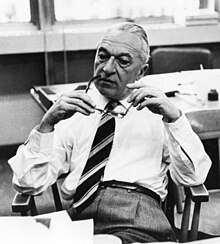Bruno Rossi
Bruno Benedetto Rossi (born April 13, 1905 in Venice , † November 21, 1993 in Cambridge , Massachusetts ) was an Italian astrophysicist and elementary particle physicist .
Life
Rossi received his doctorate at the University of Bologna and was from 1928 assistant at the University of Florence . In 1932 he became a professor of experimental physics at the University of Padua . As a Jew, he lost his professorship in 1938 and went to the USA via Copenhagen and Manchester , where he was a visiting scholar at the University of Chicago in 1939 . In 1942 he became an associate professor at Cornell University . During World War II, he worked on radar development at the Massachusetts Institute of Technology (MIT) Radiation Lab and later on the nuclear weapons program in Los Alamos (he co-led the detector development group). In 1946 he became a professor at MIT, where he again studied cosmic rays and in the late 1950s was a pioneer of rocket experiments, e.g. B. to measure the interplanetary plasma and (as a consultant to American Science and Engineering Inc.) discovered the first X-ray source outside the solar system (Scorpio X-1). In 1965 he became an institute professor at MIT. In 1970 he retired there and taught at the University of Palermo from 1974 to 1980 . Kenneth Greisen is one of his PhD students .
plant
Bruno Rossi was a pioneer in the research of cosmic rays in the 1930s and was one of the first to detect cosmic X-rays with rocket experiments .
In 1939 he was the first to demonstrate the decay of the muon at the University of Chicago and measured (at Cornell University) its mean lifespan.
Rossi also developed a number of electronic techniques in experimental physics, e.g. B. 1930 circuits for coincidence observation, 1942 the " Time to Amplitude Converter " and 1943 in Los Alamos with Hans H. Staub the "Fast Ionization Chamber".
Honors and Membership
- 1934 member of the Leopoldina ,
- 1948 member of the American Academy of Arts and Sciences ,
- 1950 Member of the National Academy of Sciences ,
- 1959 member of the American Philosophical Society ,
- 1963 Medal of Merit of the Republic of Italy,
- 1970 Gold Medal of the Italian Physical Society,
- 1971 Antonio Feltrinelli Prize of the Accademia Nazionale dei Lincei ,
- 1976 Rumford Prize of the American Academy of Arts and Sciences ,
- 1983 National Medal of Science ,
- 1987 Wolf Prize for Physics.
He was honorary doctorate from Palermo, La Paz, Durham and Chicago and honorary member of the Tata Institute of Fundamental Research (1971)
The American Astronomical Society awards him the Bruno Rossi Prize for High Energy Astrophysics in his honor . A chair at MIT is named after him.
The X-ray satellite Rossi X-ray Timing Explorer of NASA is named after him. In 2012 the asteroid (17649) Brunorossi was named after him.
literature
- Essays
- High Energy Cosmic Rays . In: Scientific American , November 1959, ISSN 0036-8733 .
- Monographs
- Moments in the Life of a Scientist ("Momenti nella vita di uno scienziato", 1987). Cambridge University Press, Cambridge 1990, ISBN 0-521-36439-6 ( autobiography ).
- High energy particles . Prentice Hall, New York 1952.
- Cosmic Rays . McGraw Hill, New York 1964.
- Introduction to the Physics of Space . McGraw Hill, New York 1970 (with Stanislaw Olbert).
- Optics . Addison-Wesley, Reading, Mass. 1957.
- Alberto Bonetti (Ed.): Cosmic ray, particle and astroparticle physics. A conference in honor of Giuseppe Occhialini , Bruno Pontecorvo and Bruno Rossi; Florence, 11.-13. September 1995 (Atti dei convegni Lincei; vol. 133). Accademia Nazionale dei Lincei, Rome 1997 (in English and Italian).
Web links
- Publications by B. Rossi in the Astrophysics Data System
- George W. Clark: Biographical Memories of Bruno Rossi (English)
- Luisa Bonolis: International scientific cooperation during the 1930s. Bruno Rossi and the development of the status of cosmic rays into a branch of physics , arxiv : 1304.5612
- Cosmic Ray Observations in Eritrea: Research Notes of Bruno Rossi , 1933
Individual evidence
- ↑ Member entry of Bruno Rossi at the German Academy of Natural Scientists Leopoldina , accessed on June 23, 2016.
- ↑ Book of Members 1780 – present, Chapter R. (PDF; 508 kB) In: American Academy of Arts and Sciences (amacad.org). Retrieved February 12, 2018 .
- ^ Member History: Bruno B. Rossi. American Philosophical Society, accessed November 6, 2018 .
- ↑ Minor Planet Circ. 79103
| personal data | |
|---|---|
| SURNAME | Rossi, Bruno |
| ALTERNATIVE NAMES | Rossi, Bruno Benedetto (full name) |
| BRIEF DESCRIPTION | Italian astrophysicist |
| DATE OF BIRTH | April 13, 1905 |
| PLACE OF BIRTH | Venice |
| DATE OF DEATH | November 21, 1993 |
| Place of death | Cambridge, Massachusetts |
